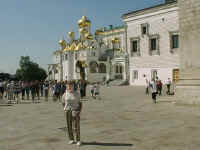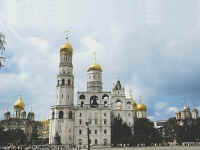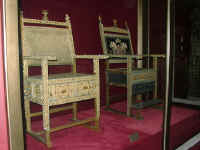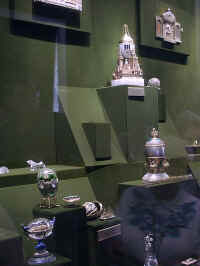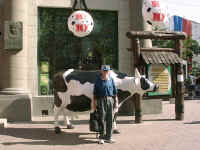Page 1 2 3 4 5 6 7 8 9 10 11 12 13 14 15
Monday, 15 July. After our light breakfast (by choice), the bus left at 9:00 a.m. to take
us to the Kremlin. This was a workday, and the difference in the volume of traffic compared to
Sunday was soon apparent. Moscow traffic is easily as bad as any large U.S. city. We finally
arrived about 9:50 and walked to the end of a long line already waiting at the entrance. The gate
opened at 10:00 and it took another half hour for us to get inside.
The Moscow Kremlin is a roughly triangular site on a small hill on the north bank of the
Moscow River. It has been settled at least since the 11th century, and the present walls date from
the late 15th century. By the time of Ivan the Great (1462-1505), Moscow was the dominant city
of Russia and its Kremlin the most magnificent.
Our guide led us first to the Kremlin's Armory (museum), which was to be the high point
of the tour. However, upon seeing that it was already jammed with other tour groups, she took
us to see the Kremlin grounds first. We walked along the south wall of the Kremlin, with the
Moscow River to our right. To our left was the huge (500,000 sq. ft.) Grand Kremlin Palace,
commissioned by Czar Nicholas I in 1838 as his new imperial residence. Just past the palace we
came to Cathedral Square.
From the early 14th century until Peter the Great moved the capital to St. Petersburg in 1710, Cathedral Square was the city's principal public space and the heart of Tsarist Russia. Clustered around the square are a series of cathedrals, towers, and palaces reflecting the history of those four centuries. There are three main cathedrals, as well as other churches. (Multiple cathedrals are common at many Russian sites.) The oldest and largest is the Cathedral of the Assumption, built in the 1470s by Ivan the Great as the seat of the Russian Orthodox Church. Here all the coronations and funerals of the Tsars were held. Only a decade later, the Cathedral of the Annunciation was erected next to it. In 1508, the Cathedral of Archangel Michael was added. Unfortunately, our guide said we didn't have time to see the interiors of the cathedrals. At the foot of the Ivan the Great Bell Tower (1600), the Kremlin's tallest structure (263 ft.), we saw the 200-ton Tsar Bell (1737 - never rung). A little further on, we saw the 40-ton Tsar Cannon (1586 - never fired). There were also many old palaces now used as government offices. Finally leaving Cathedral Square, we walked back to the Armory. The present Armory building (1851) replaced a 16th century factory for making weapons and armor. Hence the name. But the Armory is, in fact, a large museum housing a vast collection of Russian national treasures and historical artifacts. There were weapons and armor, clothing, dishes and goblets, religious items, coaches, crowns, thrones, jewelry and, of course, Faberge eggs (one with a complete trans-Siberian train inside, made of gold and platinum). We spent about an hour in the museum and only saw a small fraction it. The bus got us back to the Tolstoy for lunch at 1:30. We had signed up for an optional tour of Moscow's famous Metro (subway) stations, leaving by bus at 3:00, and it was a rush to make it. It also was a mistake to sign up because Jane was already exhausted, and we easily could have seen the subway stations on our own when we had more time. Anyway, the finest stations are the oldest ones, opened in the 1930s. Our bus took us to the Belarus railway station where we caught the first subway train. We visited four different stations, each decorated in a different style with stained glass, murals, mosaics, sculpture, and fancy chandeliers. They were attractive for subway stations but definitely showed a Stalinist touch.
We emerged from the subway near Arbat street, said by our guide to be an upscale pedestrian street with fascinating shops. But we were disappointed and found it rather ordinary. Our group met "at the cow" at 5:30 and took the bus back to the Tolstoy. We had diner at 6:30 and retired before 10:00. Jane was exhausted and not feeling well. She had medical problems for most of the rest of the trip, but they will not be detailed in this journal. Let me just say that the Tolstoy had a resident doctor aboard, and Jane thought he was excellent. (He also served as the masseur.)
Copyright © 2000-2023 DarrellPeck.com All rights
reserved. | ||||||||

